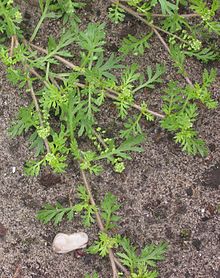Lepidium didymum
| Lesser swine-cress | |
|---|---|

| |
| Scientific classification | |
| Kingdom: | Plantae |
| Clade: | Tracheophytes |
| Clade: | Angiosperms |
| Clade: | Eudicots |
| Clade: | Rosids |
| Order: | Brassicales |
| Family: | Brassicaceae |
| Genus: | Lepidium |
| Species: | L. didymum
|
| Binomial name | |
| Lepidium didymum | |
| Synonyms | |
|
Coronopus didymus[2] | |
Lepidium didymum, the lesser swine-cress,[3] is a species of flowering plant in the family Brassicaceae.
Description[edit]
Lepidium didymum is an annual or biennial herb[4] with decumbent or ascending and glabrous green stems, up to 40 centimetres (16 in) long, radiating from a central position. The leaves are pinnate and alternate and can reach a length of 5 cm (2 in). It blooms between July and September. The flowers are inconspicuous, the four white petals very short or absent, with 2 (rarely 4),[5]: 54 stamens and the fruits consist of two rounded valves, notched at the apex, with a very short style between.[6]: 405 [7] They are also wrinkled and contain orange or reddish brown seeds, that are 1–5 mm long.[7]
Taxonomy[edit]
It was first described and published by the Swedish botanist Carl Linnaeus in 'Mant. Pl.' (Mantissa Plantarum) on page 92 in 1767.[8][1]
The specific epithet didymum, refers to the Greek word δίδυμα for 'twin' or 'in pairs',[9] referring to the seed capsule.
Distribution[edit]
Lepidium didymum is of uncertain origin,[4] but is often cited as native to South America,[6][5] mainly Argentina, Bolivia, Brazil, Chile, Paraguay, Peru, Uruguay and Venezuela.[10] It has been introduced elsewhere as a weed of cultivation. It has naturalised across the globe, from Africa, Europe, Asia, Australasia, North America and South America.[10] In Britain, it had been recorded from the wild by 1778,[4] chiefly in England and the south of Ireland,[11] growing on cultivated and waste ground, in gardens and lawns, by paths and roadsides.
Uses[edit]
The leaves of this plant are edible, and have a salty, cress or mustard flavour.[12][13]
References[edit]
- ^ a b "Lepidium didymum". The Plant List. Retrieved 2016-07-15.
- ^ "Coronopus didymus". The Plant List. Retrieved 2016-07-15.
- ^ BSBI List 2007 (xls). Botanical Society of Britain and Ireland. Archived from the original (xls) on 2015-06-26. Retrieved 2014-10-17.
- ^ a b c "Online Atlas of the British & Irish flora: Coronopus didymus (Lesser swine cress)". London, U.K.: Biological Records Centre and Botanical Society of Britain and Ireland. Retrieved 15 July 2016.
- ^ a b Clapham, A.R.; Tutin, T.G.; Warburg, E.F. (1981). Excursion Flora of the British Isles (Third ed.). Cambridge University Press. ISBN 0521232902.
- ^ a b Stace, C. A. (2010). New Flora of the British Isles (Third ed.). Cambridge, U.K.: Cambridge University Press. ISBN 9780521707725.
- ^ a b Gaby H. Schmelzer, Gabriella Harriet Schmelzer and Ameenah Gurib-Fakim (Editors) Medicinal Plants, Volume 1, p. 362, at Google Books
- ^ "Brassicaceae Lepidium didymum L." ipni.org. Retrieved 6 December 2017.
- ^ "Botanary: didymum". davesgarden.com. Retrieved 6 December 2017.
- ^ a b "Taxon: Lepidium didymum L." npgsweb.ars-grin.gov. Retrieved 6 December 2017.
- ^ "BSBI Distribution maps:Lepidium didymum". London, U.K.: Botanical Society of Britain and Ireland. Retrieved 15 July 2016.
- ^ "Lesser Swine Cress, Coronopus didymus, Lepidium didymum". Wild Food UK. Retrieved 5 May 2021.
- ^ "Swinecress, Wart Cress: Micro Mustards". Eat The Weeds and other things, too. 25 December 2017. Retrieved 5 May 2021.
